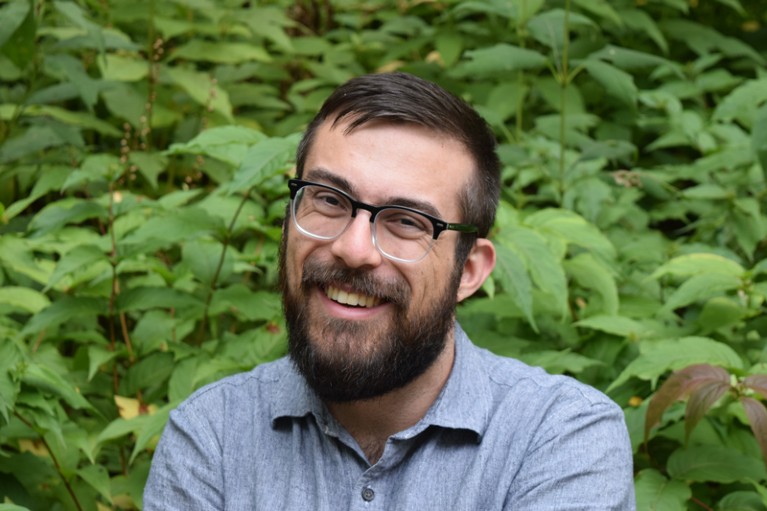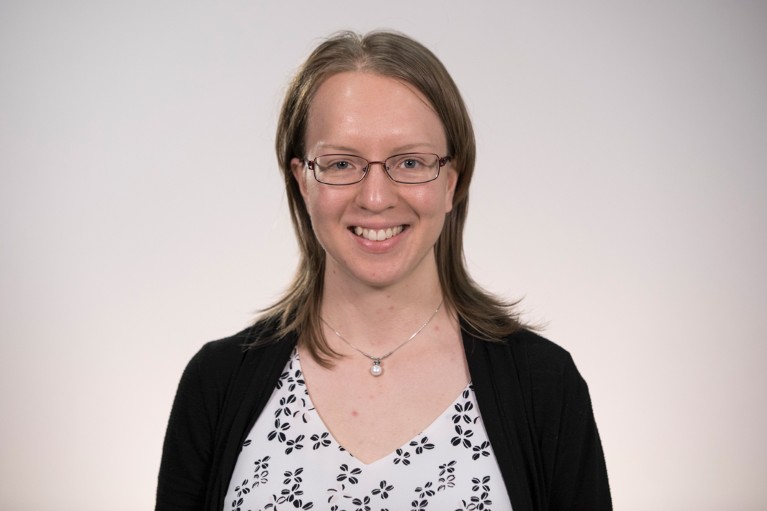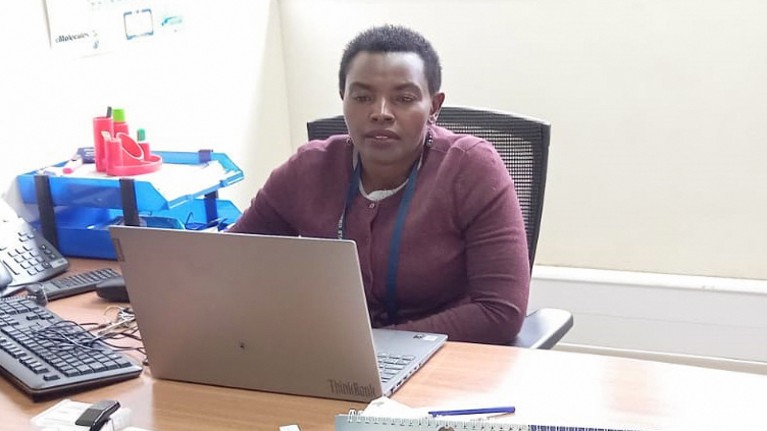BLAINE G. FISS: One step at a time

Inorganic chemist Blaine G. Fiss says that much lab equipment is inaccessible to scientists with disabilities.Credit: Jordan Bentley
My interest in chemistry began at the age of five, with a chemistry set that was a birthday gift from my parents. I remember using it while sitting in my wheelchair. Seeing acids and bases interacting with each other, and pH paper changing colour, sparked my curiosity for how the world worked. My interest grew throughout school as I learnt how molecules and materials could be created to solve humanity’s biggest challenges. On starting my academic career, I was initially drawn to nanomaterials that serve as medicines and diagnostic tools, until my third year, when a passionate professor of inorganic chemistry set me on a different path. Joining their research group sparked my passion for the field of materials with applications in clean energy.
Living with cerebral palsy, I walk with a slight imbalance and am presented daily with challenges that affect my stability, lower-body strength and fine motor control. These make many aspects of synthesis and characterization facilities rather inaccessible. Even the most common tools pose obstacles. Equipment that restricts movement can be hard, or even impossible, for chemists with physical disabilities to use. This is the case, for example, for a glovebox — in which air- and moisture-sensitive experiments are conducted — or a Schlenk line (connected tubes and flasks that allow reactions to be performed under an inert atmosphere). And nuclear magnetic resonance (NMR) spectrometers — used routinely to identify molecules — require samples to be placed into tiny tubes that are loaded at the top of the instrument, often some three metres up. When I started my PhD at McGill University in Montreal, Canada, each spectrometer was accessed using a small, unsupported stepladder placed at its base. However, I lack the balance and coordination to put myself in such a precarious position to insert or remove samples.
I initially circumvented the issue by asking colleagues for assistance. Noticing the inconvenience it caused me, the NMR facilities manager rapidly arranged for the unstable ladder to be replaced with a full wooden staircase, complete with handrails. This seemingly simple change allowed me to regain independence in a daily aspect of my research life and boosted my confidence. But not all chemists can climb stairs — installing a waist-high autoloader on all spectrometers would make them more accessible.
This illustrates what I feel is a crucial barrier facing scientists with disabilities: the inaccessibility of the facilities and equipment, as well as that of buildings and lab spaces. Large-scale improvements and adaptations for generalized accessibility are required. It is unrealistic to think that this will happen overnight, but small adjustments need to be made continuously. Over time, they will benefit everyone.
To this end, the chemistry community should let the voices of chemists with disabilities lead discussions surrounding lab planning, as well as on funding and grant support for more accessible equipment. I am optimistic that this is happening. Academic environments and the chemical industry should both continue to make changes to fully welcome, and support, chemists with disabilities.
LAENA D’ALTON: Accommodations are key to equity

Laena D’Alton has found that making PhD courses more flexible improves access to chemistry.Credit: La Trobe University
During my undergraduate studies, in 2012 I contracted a virus from which I never fully recovered, leading to a disabling chronic illness.
As a disabled chemist, I have met with a series of challenges. For example, commuting, repetitive movements and long hours of standing or moving can be difficult and sometimes impossible. I never feel fully well. Noise, lighting, smells and visual clutter all exacerbate my condition. I have developed ways to work sustainably and efficiently, such as planning shorter experiments, working in the lab during quieter times, using earplugs that soften background noise and working mainly from home.
With practical help from my family and my supervisors, who have been wonderfully supportive, I scraped through the first two years of my PhD by taking strategic breaks using both annual leave and intermissions (once my scholarship allowed it). Nevertheless, my hours became unsustainable and I switched to part-time enrolment. This wasn’t easy, because multiple approvals were required (and if I had been an international student, this might have violated my visa conditions). The switch also came with financial challenges: my part-time scholarship was not enough to live off. I was fortunate to find casual work, but it was an insecure situation to be in.
Part-time options are rare, despite the number of people who need them for a range of reasons, including disabilities or caring commitments. There is also stigma around flexible arrangements during a PhD. It might partly be because the completion rate for part-time students is lower than that of full-timers (M. Torka Aust. Univ. Rev. 62, 69–82; 2020). This does not suggest that fault lies with the graduate students, however, but that the support they receive needs to be optimized. Part-time career options with realistic workloads and appropriate support at all levels in academia would go a long way towards improving access to the field of chemistry.
Having recently completed my PhD, I now face a further set of systemic barriers that are, unfortunately, not unique to me or to Australia.
For example, conferences are often crucial to career development — not attending them can be a career killer, through missed opportunities to present your research and to network. Yet many people cannot attend in-person events, easily or at all. Any trip to an international conference from Australia is already long and expensive, even before taking into account disability-related challenges. Locations are often physically inaccessible, interpreters or live captioning are almost non-existent, programmes offer few opportunities for breaks and little is done to reduce the spread of infectious diseases. Although there are now more online and hybrid conferences, virtual participation is usually restricted to listening passively to talks. Incorporating the social aspects of conferences online would make a huge difference to equity in academia.
Government policies exist in many countries worldwide to protect disabled and neurodivergent employees from discrimination — but daily experiences often tell a different story. Labs are not suitably designed; for example, wheelchair access or adjustable-height benches and fume hoods are rare. Accessibility and workplace accommodations are often treated as if they were mere personal preferences — so much so that the most common advice I have received is not to apply for accommodations and not to disclose my condition. Furthermore, adjustments provided to undergraduate students are often not available to PhD students and university staff: whereas students can engage with a course online, for example, teachers are required to deliver lectures in person.
Disabled, chronically ill and neurodivergent people have rich experience and knowledge, and contribute in positive ways to universities and workplaces. Progress in accessibility and inclusion has been made in the past decade in Australia; I am hopeful that this will continue. And yet, the national rate of unemployment for people with disabilities (around 10%) has hardly changed in the past 20 years, and has remained twice that for people without disabilities (see go.nature.com/3sfqjb3). Workplaces should involve disabled, chronically ill and neurodivergent people when they draw up or revise their policies and arrangements. In particular, organizations need to consult those who have dropped out because of inaccessibility, to avoid ‘survivorship bias’ (when only those who stayed are asked for their views).
Scientists already innovate in science — innovating in how science is done is urgently required, too.
NAUMIH M. NOAH: Teach with an open mind

Naumih Noah endeavours to teach in a manner that is inclusive of all students.Credit: Naumih Noah
Disabled chemists face many obstacles to full and equal participation, and it is important to keep in mind that many disabilities are not visible. Students with disabilities can succeed in chemistry courses and careers if they are given access to content and activities in classes. Although seemingly obvious, this hinges on teachers and instructors adopting strategies to ensure that all students benefit — including those with specific needs.
Technology can offer some solutions. For example, laptops can help students whose fine motor skills affect their use of a pen. But in Kenya, where I work, there is a big gap between the accommodations that are offered in secondary and tertiary education. Specialized secondary schools and programmes exist for students living with impairments that interfere with their learning — these provide greater support than in general schools, and are staffed with trained teachers. But there are no specialized universities in the country, and so students leaving such schools for higher education have to navigate a large gap in terms of the support that is available.
From my experience, many university lecturers are unaware of whether students have a disability. And disclosures can be difficult for students to make, for a variety of reasons. Often, this means that their needs cannot be accommodated appropriately, meaning that disabled students are excluded from the learning process. Some students might take longer to learn, for example, whereas others might have a short attention span, which can be misconstrued as rudeness by lecturers. In turn, this perception tends to have a negative impact on students, who will not be given the attention they need. Providing university lecturers with training to support students who have impairments, visible or otherwise, would prove extremely beneficial.
Noticing that some students were not doing as well as they could in my classes, I worked with them and realized that they had impairments that were not visible. I organized and attended a workshop to train chemistry lecturers on inclusive teaching, funded by the UK Royal Society of Chemistry. It had an effect on both my perspective and my teaching pedagogy. To cater to various learning styles and abilities, I now incorporate visual aids, demonstrations, hands-on experiments and verbal descriptions in my classes — all the more necessary in chemistry, which is a visual and practical subject. I am also more flexible and patient with the students in class, and I enable them to demonstrate their understanding in different ways, not just through tests for a set period of time, at a desk, with limited resources. In particular, I have found in-class activities such as student presentations, in which they are able to express themselves orally, hugely useful.
One simple step has had a large positive impact: letting students know during our first encounter that I will be inclusive. I specifically mention, in class and on my syllabus, that they can talk to me in confidence, should they wish to, about any challenge. This has allowed students to come forward, and I have worked with them to provide accommodations. I then strive to incorporate these in my teaching practice so that they can benefit others, whether I’m aware of their needs or not.